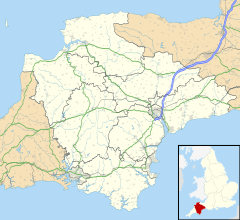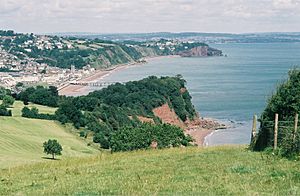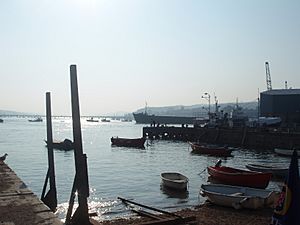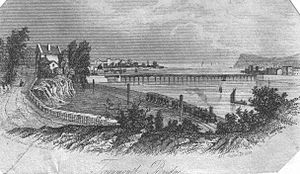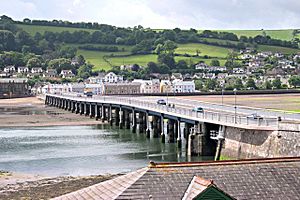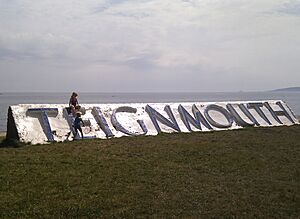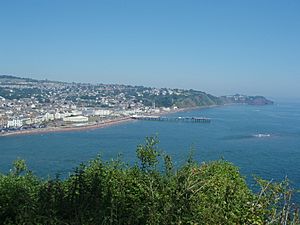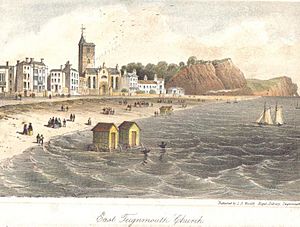Teignmouth facts for kids
Quick facts for kids Teignmouth
|
|
|---|---|
 Teignmouth |
|
| Population | 14,932 (2021 Census) |
| OS grid reference | SX945735 |
| Civil parish |
|
| District |
|
| Shire county | |
| Region | |
| Country | England |
| Sovereign state | United Kingdom |
| Post town | TEIGNMOUTH |
| Postcode district | TQ14 |
| Dialling code | 01626 |
| Police | Devon and Cornwall |
| Fire | Devon and Somerset |
| Ambulance | South Western |
| EU Parliament | South West England |
| UK Parliament |
|
Teignmouth (pronounced TIN-muth) is a lovely seaside town in Devon, England. It is also a civil parish, which is a local government area. The town sits on the north side of the River Teign's mouth. It is about 12 miles south of the city of Exeter. In 2011, about 14,749 people lived there.
Teignmouth started as a fishing port. It was known for its connection to the Newfoundland cod industry. In the 1800s, it grew quickly. It became a popular holiday spot during the Georgian era. Even more people came after the South Devon Railway opened in 1846. Today, the port is still busy. Teignmouth remains a favorite place for holidays and day trips.
Contents
History of Teignmouth
Early Days to 1700
The name Teignmouth, Tengemuða, means 'mouth of the stream'. It was first written down in 1044. But people lived nearby much earlier. Saxons controlled the Teign estuary banks by 682. A battle between Britons and Saxons happened on Haldon in 927. Danish raiders also attacked the Teign estuary in 1001.
There were once two villages: East and West Teignmouth. A stream called the Tame separated them. This stream flowed into the Teign through marshland. Neither village is in the Domesday Book. But East Teignmouth got permission for a market in 1253. West Teignmouth got its market a few years later. The Tame stream now flows underground. You can only see it higher up as Brimley Brook.
By the early 1300s, Teignmouth was an important port. It was second only to Dartmouth in Devon. The French attacked it in 1340. In 1347, Teignmouth sent seven ships and 120 men to fight at Calais. Its importance went down in the 1400s. This might have been because tin mining on Dartmoor caused the harbour to fill with mud.
In the 1600s, Teignmouth ships faced attacks. These came from Dunkirkers, who were privateers from Flemish ports. Smuggling might have been the town's main trade then. But cod fishing in Newfoundland was also very important.
In July 1690, the French fleet attacked Teignmouth. This happened after they beat an Anglo-Dutch fleet. The people of Teignmouth wrote about what happened. They said about 1,000 French invaders arrived. In three hours, they burned over 240 houses. They stole everything and damaged the churches. They also burned ten ships and many fishing boats.
After checking the facts, officials agreed. They said 116 houses were burned down. Another 172 houses were robbed. Two churches were badly damaged. Ten ships were also burned. Because of this, the King asked for money to help the town. Churches from all over England sent money. This helped the port to grow even more. This was the last time England was invaded. French Street, where the museum is, is named after this event.
In the 1600s and 1700s, a windmill stood on the Den. The Den was a large sand dune back then. Today, it is a grassy public park near the sea. The windmill was taken down by 1759.
From 1700 to Today
In the late 1700s, privateering was common in Teignmouth. Privateers were private ships allowed to attack enemy ships. In 1779, a French ship full of sugar and coffee was sold in Teignmouth. People from Teignmouth also prepared two privateer ships. One was called Dragon and the other Bellona. Bellona sank on its first trip, and 25 crew members were lost.
Fishing in Newfoundland was the main job until the early 1800s. Men went to Newfoundland for most of the year. So, women did the local fishing. They also rowed ferries across the river. Early visitors called the women of Teignmouth "Amazonians." They wrote about their strength and how they wore trousers to fish.
As fishing became less important, tourism grew. A tea house was built on the Den in 1787. By 1803, Teignmouth was a "fashionable watering place." The town continued to grow in the 1800s. Its two churches were rebuilt after 1815. In the 1820s, the first bridge to Shaldon was built. George Templer's New Quay opened at the port. The esplanade, Den Crescent, and the Assembly Rooms were also built. The railway arrived in 1846. The pier was built between 1865 and 1867.
A local story from 1900 tells about the Bishop of Exeter visiting Teignmouth. A priest was guiding him. The story says the devil turned them both into stone. These stones are seen as two rock stacks in the sea.
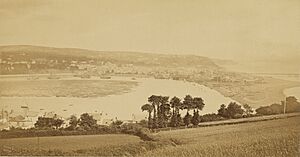
The First World War greatly affected Teignmouth. Over 175 men from the town died. Many businesses also closed down. In the 1920s, the economy started to get better. A golf course opened on Little Haldon. The Morgan Giles shipbuilding company started. Buses took families on trips to Dartmoor. By the 1930s, the town was doing well again. Teignmouth was even advertised as a place with full aviation facilities. This was because of the nearby Haldon Aerodrome.
During the Second World War, Teignmouth was bombed many times. It was attacked 21 times between 1940 and 1944. 79 people were killed and 151 were hurt. 228 houses were destroyed, and over 2,000 were damaged. Teignmouth's hospital was bombed in 1941. Three nurses and seven patients died. The hospital was rebuilt and opened in 1954. It was the first general hospital built after the National Health Service started.
The US Navy had a plan to build a seaplane base here. But they stopped the plan as the war turned in favor of the allies.
Teignmouth Port
The port of Teignmouth has been active since the 1200s. Today, it mainly handles clay, timber, and grain.
The Old Quay was built in the mid-1700s. The Stover Canal opened in 1792. This helped the port a lot. It made it easy to transport ball clay from mines near Newton Abbot. Barges carried the clay down the canal and estuary to the port. By 1820, granite from Haytor on Dartmoor was also shipped. This granite traveled on the unique Haytor Granite Tramway. The granite for the new London Bridge came from here. It was sent from the New Quay, built between 1821 and 1825.
The Old Quay was sold in 1850. It became a main part of George Hennet's trading business. It was connected to the South Devon Railway in 1849.
Until 1852, Teignmouth was legally part of the Port of Exeter. After many years of trying, Teignmouth became independent in September 1852. This was a big reason for celebration in the town.
Teignmouth has a history of shipbuilding since the 1600s. By the early 1800s, there were three shipyards in Teignmouth. There were also three in Shaldon and Ringmore. The industry slowed down in the early 1900s. But in 1921, Morgan Giles bought the last shipyard. This brought new life to the industry. His shipyard became a major employer. It built pleasure boats in peacetime. During World War II, it built small boats like torpedo boats. The business closed in 1968.
The Shipwrecked Fishermen and Mariners' Royal Benevolent Society sent a lifeboat to Teignmouth in 1851. It was kept in a boathouse on the beach. In 1854, the society gave its lifeboats to the Royal National Lifeboat Institution (RNLI). A new boathouse was built on The Den. It was used until 1940. After 50 years, the RNLI reopened Teignmouth Lifeboat Station in 1990. They used an Atlantic 21 inshore lifeboat.
Teignmouth's lighthouse was built in 1845. It helps guide ships into the harbour.
Shaldon Bridge
The first bridge was owned by the Teignmouth and Shaldon Bridge Company. It opened on June 8, 1827. It had 34 wooden arches. It was 1,671 feet long, making it the longest wooden bridge in England at the time. It had long walls at each end. There was also a swing bridge at the Teignmouth end. This allowed sailing ships to pass up the river. It cost about £19,000 to build. Toll houses were built at each end. The one on the Teignmouth side is still there.
After eleven years, on June 27, 1838, the middle arches of the bridge fell down. Shipworms had eaten through the wood. It was rebuilt with wood and reopened in 1840. But it partly collapsed again in 1893. The bridge was completely rebuilt between 1927 and 1931. Steel was used for the piers and main beams. Concrete was used for most of the deck.
On October 28, 1948, Devon County Council bought the bridge. They paid £92,020 for it. After that, people no longer had to pay tolls. The original paint did not protect the bridge well. Repairs were needed in 1960 and 1980. In 1998, serious problems were found with the bridge's structure. Work to fix this continued until 2002. The bridge stayed open during this time. After the work, people noticed the bridge "whistles" in certain winds. This problem had not been fixed by 2007.
In February 2016, Devon County Council said the movable part of the bridge would be raised. This would be the first time since 2002. This is to follow a rule from when the bridge was built. The rule says the opening section must be kept working.
Getting Around Teignmouth
Railway Travel
Teignmouth railway station opened in 1846. It is very close to the town center. The station is on the Great Western Main Line. This line connects London Paddington to Penzance in Cornwall. In 2018–19, 706,000 passengers used the station. This made it the second busiest station on the Riviera Line.
Two train companies serve the station:
- Great Western Railway runs regular trains every half hour. These trains go between Exmouth, Exeter, and Paignton. Some longer-distance trains also stop here. These go between Plymouth, Paignton, and London Paddington. Others go between Cardiff, Bristol, Plymouth, and Penzance.
- CrossCountry trains stop here twice a day in each direction. These trains travel between Manchester Piccadilly and Paignton.
Railway History
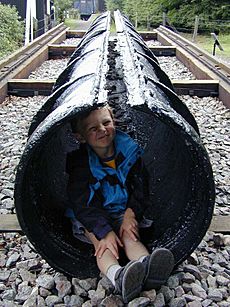
The railway line was built by Isambard Kingdom Brunel. It runs along the South Devon Railway sea wall. This is a stone wall between the sea and cliffs. It stretches for miles between Teignmouth and Dawlish Warren. This line was first built with a wider track. It also used an atmospheric system. This system used steam pumps to create a vacuum. But it did not work well. So, it was changed to use normal steam trains. Old parts of the atmospheric railway pipes were used as drains in Teignmouth.
In December 1852, a big landslip closed the railway for four days. This happened from the cliffs east of town. In 1855 and 1859, the sea broke through the line at Teignmouth. There have been many more closures since then. These are caused by landslips and sea damage, especially in winter. In 2010, maintaining the sea walls cost Network Rail about £500,000 a year. In 1936, the Great Western Railway planned a different route inland. But World War 2 stopped these plans.
Bus Services
Local bus services are mainly run by Stagecoach South West and Country Bus. Important bus routes that serve Teignmouth include:
- Route 2: From Exeter to Newton Abbot
- Route 22: From Dawlish Warren to Paignton
- Route 81: From the town center to Teignmouth Morrisons supermarket
Teignmouth's Location and Weather
Geography
Teignmouth is on the north bank of the River Teign's mouth. It is where several main roads meet. These include the A379 coast road and the A381 road to Newton Abbot. The B3192 road goes up to the A380 on Haldon. From there, you can reach the M5 about 19 km away. Teignmouth is connected to Shaldon, a village on the other side of the river. You can cross by a passenger ferry or by a road bridge further upstream. The red sandstone headland on the Shaldon side is called "The Ness." It is the most famous symbol of the town from the sea.
In the harbour area, there used to be a small island called the Salty. It was made from mud dug out of the river. But it was flattened recently. This was to help keep the main shipping channel clear. Now it is a large sand bank at low tide. Seabirds and people collecting cockles visit it. Locals still use salmon nets, especially near Shaldon Bridge.
The river mouth looks very wide for the size of the river. This is especially clear at low tide. It is a drowned valley. This means the sea level rose after the last Ice Age, flooding the valley.
Climate
Teignmouth is on the coast of Devon. Devon is a peninsula in South West England. Teignmouth has a mild maritime climate. This means its weather is influenced by the sea. Winds usually come from the west across South West England. Teignmouth is to the east of Dartmoor. This means it is in a rain shadow. Its average temperatures are 3 °C higher than Princetown on Dartmoor. It also gets less than 43% of the rain that Princetown gets. Teignmouth gets 133 mm less rain each year than nearby Plymouth.
Because it is near the sea, Teignmouth has warmer winters. There is less frost and snow. Summers are slightly cooler than inland areas of southern England. January is usually the coldest month in Britain. But sea temperatures are lowest in late February. This makes February the coldest month in Teignmouth. The first frost usually happens in late November or early December. In contrast, central England can have frosts as early as September.
Snow is rare at the start of winter in December. Late autumn and early winter are the wettest times. This is because sea temperatures are still high. Deep Atlantic depressions bring moist air across the South West. On average, July is the driest month. But summer thunderstorms can sometimes bring a lot of rain in one day. Teignmouth gets over 7 hours of sunshine a day in summer. In winter, it gets around 2 hours. Sunshine amounts depend on daylight hours. They also depend on the Azores High, which is strongest in summer. The climate also has a small Mediterranean climate influence. This means less rain in summer and more in winter.
The Teignmouth weather station is in an area open to sea breezes. This means temperatures there are not as extreme. Other parts of the town and area are more sheltered. Temperatures at the station have gone up every month. This is comparing the 1981–2010 and 1991–2020 periods. There has been noticeable warming in spring and autumn. There has also been a small overall increase in rainfall.
| Climate data for Teignmouth 7m asl, 1991–2020 | |||||||||||||
|---|---|---|---|---|---|---|---|---|---|---|---|---|---|
| Month | Jan | Feb | Mar | Apr | May | Jun | Jul | Aug | Sep | Oct | Nov | Dec | Year |
| Mean daily maximum °C (°F) | 9.7 (49.5) |
9.7 (49.5) |
11.2 (52.2) |
13.4 (56.1) |
16.2 (61.2) |
19 (66) |
21.1 (70.0) |
21 (70) |
19 (66) |
15.7 (60.3) |
12.5 (54.5) |
10.4 (50.7) |
14.9 (58.8) |
| Daily mean °C (°F) | 6.9 (44.4) |
6.8 (44.2) |
8.1 (46.6) |
9.9 (49.8) |
12.7 (54.9) |
15.4 (59.7) |
17.4 (63.3) |
17.4 (63.3) |
15.5 (59.9) |
12.6 (54.7) |
9.6 (49.3) |
7.5 (45.5) |
11.7 (53.1) |
| Mean daily minimum °C (°F) | 4.2 (39.6) |
3.8 (38.8) |
5 (41) |
6.5 (43.7) |
9.1 (48.4) |
11.8 (53.2) |
13.7 (56.7) |
13.8 (56.8) |
11.9 (53.4) |
9.6 (49.3) |
6.6 (43.9) |
4.6 (40.3) |
8.4 (47.1) |
| Average rainfall mm (inches) | 96.6 (3.80) |
73.3 (2.89) |
67.2 (2.65) |
60.6 (2.39) |
53.6 (2.11) |
55 (2.2) |
46 (1.8) |
62.5 (2.46) |
57.1 (2.25) |
101.9 (4.01) |
98.2 (3.87) |
101.3 (3.99) |
873.2 (34.38) |
| Average rainy days | 13.1 | 11.2 | 9.9 | 9.9 | 8.6 | 8 | 7.3 | 9.2 | 7.8 | 12.5 | 13.1 | 13.4 | 124 |
| Mean monthly sunshine hours | 64.1 | 86.8 | 127.8 | 186 | 216 | 220.4 | 219.5 | 200.2 | 162 | 114.3 | 80.8 | 59.2 | 1,737.2 |
| Source: Met Office | |||||||||||||
Buildings and Places to See
Den Crescent and its central Assembly Rooms were built in 1826. They still look much the same today. The Assembly Rooms were the main place for social events in the 1800s. Fancy balls were held in the 70-foot-long ballroom. In 1871, a club for wealthy people took over the building.
Over the years, the building was a theatre, a dance hall, and a billiards hall. In 1934, it became the Riviera Cinema. It stayed a cinema until 2000. Part of the building is now flats. In 2016, a church took over the historic auditorium. They plan to make it a cinema and arts center again.
The town's main church, St. James, is unusual. It has an octagonal, or eight-sided, shape. A story from Cornwall says round churches were built to keep the Devil out. The Devil had no corners to hide in. So, these buildings were 'Devil-proof.' The church of St Michael the Archangel is in the east of town. St. Scholastica's Abbey, now flats, is a beautiful Gothic Revival building. The Roman Catholic Church is also on the same road.
In 1894, Teignmouth had 26 public houses (pubs). Today, pubs include the Blue Anchor Inn and the Devon Arms. The River Beach has many colorful beach huts. One of them, now in the museum, was an old Georgian bathing machine. These huts have become very popular. They can now sell for close to £100,000.
The Teignmouth and Shaldon museum was finished in 2011. It has a modern extension to the old 18th-century building. It includes a roof terrace with town views and a glass tower. Some exhibits include a restored bathing machine. There are also items from the Church Rock wreck, like cannons. You can see things from the nearby Haldon aerodrome. There is also film footage of The Beatles visiting the town. The band Muse's homecoming concerts from 2009 are also shown. The new building cost almost £1.1 million. The community raised a lot of money for it.
The town's newest public building is the Pavilions Teignmouth. It is a community arts and business center on the Den. It opened in April 2016.
Teignmouth Today
On July 27, 2005, Teignmouth became Devon's first Fairtrade Town. Also in 2005, a volunteer group made a plan for Teignmouth. This plan looked at issues to fix by 2015. These issues included improving tourism and preventing floods. They also wanted to provide affordable homes.
In May 2010, the local council shared a plan called A Vision for Teignmouth. This plan had 21 projects to improve the town. A skatepark opened on the seafront in July 2010. Flood defenses at the Fish Quay were finished in October 2012.
Two movies have been filmed in Teignmouth. The Mercy, starring Colin Firth, and Press for Time, starring Norman Wisdom. Both films have many scenes shot in the town.
Tourism and Fun Things to Do
Teignmouth still attracts many visitors, especially for day trips. It is twinned with Perros-Guirec in France.
The town has a sea beach and Teignmouth Pier. The pier has an amusement arcade and rides. The beach also wraps around the river mouth. This part is called the Back Beach. Dogs are allowed here all year. From here, you can see the harbour and boats. You can also see up the river to Dartmoor. A long walking path called the Templer Way is 18 miles long. It goes between Haytor on Dartmoor and Shaldon. It follows the old routes of a granite tramway and a canal.
Teignmouth Carnival is held in the last week of July. The main parade is on the last Thursday. Since 1999, the town has also hosted a summer folk festival. In 2005, singers from Newfoundland were the main performers. This celebrated the town's history with that region.
In 2014, a group created a website to help tourists visit the town. Since 2018, Teignmouth has hosted the annual Teign Shanty Festival. This is a folk music festival focused on sea shanties. In 2021, over 40 groups performed.
Schools in Teignmouth
Teignmouth Community School is a local secondary school. It includes a sixth form for older students. It was formed in 1979 by joining two other schools. More recently, it merged with a primary school.
Other secondary schools include Trinity School. This is a private school with boarding options.
Primary schools include:
- Our Lady & St Patrick (OLSP) (a Roman Catholic School)
- Hazeldown
- Mill Lane
Media and News
Local TV news comes from BBC South West and ITV West Country. TV signals are received from Beacon Hill and Stockland Hill transmitters. There are also two local relay transmitters. Local radio stations include BBC Radio Devon (104.3 FM) and Heart West (96.4 and 103 FM). You can also listen to Greatest Hits Radio Devon (105.5 FM), Radio Exe (107.3 FM), and East Devon Radio (106.4 FM). The town's local newspaper is the Teignmouth Post. It is part of the Mid Devon Advertiser and comes out on Fridays.
Sports in Teignmouth
Teignmouth is home to Teignmouth A.F.C., a football club. Their first team plays in the South West Peninsula League. The town also has Teignmouth R.F.C., a rugby club. The Den Bowling Club is on the seafront. It hosts the Teignmouth Open Bowls Tournament. Teignmouth Shotokan Karate Club started in 1984. They train twice a week.
The seafront has Teignmouth Lido. This is a public outdoor heated swimming pool. It is one of four outdoor pools run by the local council.
Teignmouth is home to the River Teign Rowing club. It is the largest rowing club in the UK. It has almost 400 members. The club competes internationally in Cornish Pilot Gig rowing. They also race Seine boats locally. Members have competed as far away as Russia.
Teign Corinthian Yacht Club was founded in 1886. It organizes races and training for sailing boats. It has a clubhouse on Teignmouth seafront. It also has a dinghy park on the River Teign estuary.
Famous People from Teignmouth
Fanny Burney, a famous writer, visited Teignmouth many times in the late 1700s. She wrote in her diary about swimming in the sea here in 1773. Elias Parish Alvars, a harp player, was born in East Teignmouth in 1808. Three years later, Thomas Abel Brimage Spratt, a vice-admiral and geologist, was born at Woodway House.
In spring 1818, the poet John Keats spent weeks in Teignmouth. He finished his long poem Endymion here. He wrote to a friend about the "abominable Devonshire Weather." He called it a "splashy, rainy, misty, snowy, foggy, haily, floody, muddy, slipshod county."
George O. May (born 1875) was a very important person in accounting. He became a senior partner at Price Waterhouse. He was born and grew up in Teignmouth.
From 1812 until his death in 1833, Edward Pellew, 1st Viscount Exmouth lived at Bitton House. Meanwhile, Thomas Luny, a painter of sea scenes, lived in town for 30 years. He painted over 2,200 pictures here. Soon after, George Hennet, a railway engineer, moved to town. He was involved with Brunel's railway. He died here in 1857.
Charles Babbage (1791–1871) was a mathematician and inventor. He came up with the idea of a programmable computer. He also lived here for some years. He was married in St Michael's church in town.
Sir John Smyth (1893–1983) received the Victoria Cross. He was made the 1st Baronet of Teignmouth in 1956.
The Belgium footballer Charles Vanden Wouwer was born in Teignmouth in 1916. His parents were staying there as refugees during World War I.
The Canadian World War II pilot Roy Sydney Baker-Falkner settled in Teignmouth in 1930. He was one of the few naval pilots in the Battle of Britain. He was given the freedom of Teignmouth and Exeter. He is remembered on the Shaldon War Memorial and at the Teign Heritage Museum.
During World War II, Clive Sinclair was evacuated to Teignmouth as a child. He lived there for some years.
The musician Danny Thompson was born in town in 1939. The writer John Bainbridge (born 1953) spent his teenage years here.
The Norman Wisdom film, Press for Time, was largely filmed in Teignmouth in 1966. Norman plays a reporter in the seaside town of "Tinmouth." A bus and bicycle chase shows many scenes of the town center and seafront from that time.
The next year, on October 31, 1968, Donald Crowhurst started his attempt to sail around the world alone. He started from Teignmouth. His boat was named the Teignmouth Electron. This was after the town and his electronics company. The film The Mercy, released in 2018, shows this sad event. It stars Colin Firth and Rachel Weisz.
The three members of the rock band Muse went to Teignmouth Community College. They started the band in Teignmouth. Their song "Falling Down" is about their teenage years there. The band played two homecoming concerts in Teignmouth in September 2009. These were called A Seaside Rendezvous.
Singer-songwriter Patrick Wolf wrote a song called "Teignmouth." It is on his 2005 album Wind in the Wires. The song focuses on the view of the town and the River Teign from a train.
England rugby union player Sam Simmonds lives in Teignmouth. His brother Joe Simmonds, also a rugby player, lives there too. Sam helped his team win the Aviva Premiership in 2017.
The triple jump world record holder Jonathan Edwards lived in Teignmouth when he was young. He went to school at the Inverteign Juniors site. His world record has stood since 1995.
Composer Laura Rossi grew up in Teignmouth and went to school there.
Teignmouth in Art and Books
Letitia Elizabeth Landon wrote a poem called A Legend of Teignmouth. It was in Fisher's Drawing Room Scrap Book, 1834. It goes with a picture of Teignmouth from the Ness by Thomas Allom.
See also
 In Spanish: Teignmouth para niños
In Spanish: Teignmouth para niños


